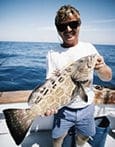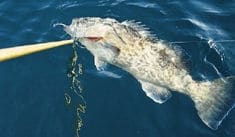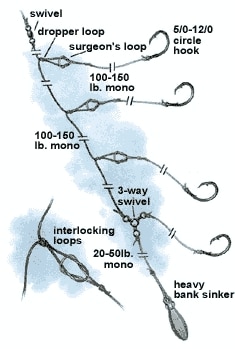There had been no wind for two days and the baitfish schools were thick offshore. In northeast Florida, that’s a recipe for awesome bottom fishing, and local expert Danny Patrick was in the thick of it. He called to tell me he was hammering big grouper, and wanted to know if I’d like to join him on his next trip. My answer was an emphatic “yes!”
The next morning I met Danny in the small town of Mayport on the St. Johns River. We loaded our gear into his 25-foot Angler, then zipped through the inlet and into the open ocean. The seas were still calm, but there was an autumn chill in the air that made us glad we had brought our heavy coats, sweatshirts and stocking caps.
Fall grouper and snapper fishing has always been good within 15 miles of northeast Florida. But over the past few years the action has been nothing short of incredible, especially with gag grouper, although no one is exactly sure why. Size and bag limits may be one reason, or it could be simply an “up” cycle in the bottom fishery. Whatever the case, when the air temperature drops and the water temperature holds in the 58-to-75-degree range, it’s time to head offshore for grouper!
Kick-Off Time
“I fish for grouper year-round, and get ’em pretty well even in mid-summer,” explained Danny as we raced across the Atlantic. “But the best fishing happens when it starts to get cool. When the air is crisp, the sun bright and the seas slick – that’s grouper time in my book!”
After a 20-minute run, the GPS unit beeped, letting us know that we had arrived at Danny’s chosen hot spot. The bulk of northeast Florida grouper fishing takes place on the reefs and ledges from five to 15 miles offshore. The GPS and loran numbers for these unmarked spots are closely guarded secrets among grouper experts, but fishermen who do their homework and stay on the lookout for irregular bottom while running offshore and back can locate some prime areas of their own.
Most ledges run north-south, so an east-west search pattern is usually most productive when hunting for potential hot spots. A good tip-off in calm weather is the presence of baitfish, such as cigar minnows, boiling on the surface. The bait often holds over undulating “live” bottom, and warrants investigation with a depthsounder. Many times, individual grouper can be picked up by the sounder, particularly the kind of sensitive color scope that Danny uses.

While finding the ridges and reefs frequented by big grouper is important, anglers must also know how to position the boat precisely over the drop-off. This tiger grouper sports subtle markings that differentiate it from gag grouper.|
Drop-Off Anchoring
“Proper anchoring is vital to success,” Danny explained as he kept his eyes glued to the sounder and ran a search pattern to pinpoint the ledge. “If you’re off by just a few feet, your baits will be completely off the ledge. If you don’t put your baits right where they have to be – along the drop-off – you might as well go trolling for kingfish or cobia, ’cause you’re sure not gonna catch grouper, at least not quality fish.”
After ten minutes of searching, Danny finally located the drop-off he was looking for and we dropped anchor. In this game, anchoring is just as important as locating a productive spot. You must be able to determine the effects of current and wind, and position the boat precisely over the drop-off you want to work. Do it right and you’ll feel like a grouper-catching genius. Do it wrong and you’ll catch nothing but grunts.
One key to success is fishing your baits on the deep side of the ledge. Take a drop-off that falls from 68 to 73 feet, for example. You might mark lots of baitfish on the high part of the drop, at 68 feet, but the grouper will almost always hold on the deep side, in this case 73 feet. And that’s where your baits need to be.
Speaking of baits, a wide variety of them will take grouper. Most fishermen use pieces of frozen squid, cigar minnows and mackerel, but the real sharpies pack a variety of baits on every trip in case the fish show a preference for one type.
Live baits also work very well, and can be caught while anchored on good grouper bottom. Top offerings include cigar minnows, pinfish and grunts, which can be taken on Sabiki rigs or pieces of shrimp fished on small hooks.
Patience Pays
Once you’re anchored in the right spot and have your baits in the pay-off zone, expect to wait a bit for the grouper to arrive. “You normally have to work each spot for a while to get the fish’s attention, even when your baits are positioned perfectly,” Danny said as he sent a big cigar minnow to the bottom. “I don’t know for sure what really goes on down there in Grouperville, but I think that small grunts, snapper and baitfish come over to investigate bait when you first send it down. You may hook a few of these little fish, crank ’em up, and send down more baits. Meanwhile, little pieces of fish and squid break off and start a mini feeding frenzy. All that commotion eventually attracts grouper. I’ll often fish a place for 15 or 20 minutes before I catch a grouper. Then I’ll quickly catch another, and another. It happens too often to be coincidental.”

Grouper well over the minimum size can be gaffed, but those that are “close” should be netted or lifted aboard by the leader. Use of a venting tool can help ensure released grouper make it back down to the bottom.|
As it turned out, Danny perfectly described the action we had that day. We soaked baits for about 20 minutes without much happening. Then Danny got a hit. He set the hook and began cranking furiously to get the fish away from the ledge and moving toward the surface. Seconds later, something grabbed my bait.
Danny boated his ten-pound gag in half the time it took me to land my eight-pounder. By the time I got my fish in the boat, Danny was hooked up to another grouper, this one weighing 12 pounds. In the next 30 minutes we lost three fish and landed one more gag – filling our legal limit of four – plus a couple of red snapper. Then Danny suggested we try another spot before heading in.
We ran inshore, located another ledge and soon added a couple dozen black sea bass and two more red snapper to the box. We also released six or eight undersized grouper.
Great bottom fishing like the kind Danny and I experienced is always special, but it’s becoming more common off northeast Florida, especially in the fall. Danny says that October and November are his favorite months for grouper fishing off Mayport, but adds that choice action is available right through the winter and spring.
Bottom-Fishing Boom
“There’s no question that grouper fishing has improved off Mayport over the last few years, and I really believe that conservation is the reason,” says Danny. “I catch small snapper and grouper all the time that have hook marks in their mouths. This proves that undersized fish, if handled and released carefully by sportsmen, can and do survive, and that helps the entire fishery.”
A number of other grouper captains credit the boom in bottom fishing to natural factors, namely water clarity. They point out that the water north of the St. Johns River is a bit murkier than south of the river. For that reason, they say, divers are less efficient at spearing grouper and snapper on the ledges, so there are more fish available to hook-and-line fishermen. The theory has merit, since the current here flows north, and a number of rivers pour into the ocean between Mayport and Fernandina. Run-off from the St. Johns, St. Marys, Nassau and other rivers likely clouds the offshore water off Fernandina, which makes spearfishing more viable farther south, most notably off St. Augustine.
On the other hand, fishing for grouper and snapper has also improved dramatically off St. Augustine in the last few years, so perhaps regulations are responsible. Or it could be simply a natural upswing in the grouper population, or a combination of factors. Whatever the reason behind the recent bottom-fishing boom off northeast Florida, one thing is clear: no one is complaining!
Bottom Rig

Danny Patrick used to fish commercially for grouper. It’s a tough way to make a buck, so the most efficient methods are always employed. While he doesn’t fish for the market anymore, Danny’s days as a commercial fisherman taught him valuable lessons that he still uses today when fishing for fun. One of these was how to make the Christmas Tree bottom rig, a multi-hook setup that scores big on grouper, snapper and even sea bass.
“The key is to use circle hooks,” says Danny. “Fishing with circle hooks is a bit different than with other hooks, because, when a fish hits, you don’t strike to set the hook. Instead, you just kind of keep moving the rod tip a bit, and the fish moves the bait around in its mouth and sets the hook itself. It sounds crazy, but it works, and once that circle hook is set it’s almost impossible for the fish to get rid of it.
“What’s great about the circle hook on the Christmas Tree rig is that you have four or five hooks down there, and because you don’t jerk the rod to set the hook, you don’t disturb the baits. So it’s common to catch several fish at one time. Naturally, that’s not always possible with big, strong grouper that head for a line-cutting ledge or hole. But often you’ll get several snapper, a sea bass and a decent grouper, too.”
Danny rigs his circle hooks on short sections of 100- to 150-pound mono with a surgeon’s loop tied in the end. These are attached to loops along the main leader. His favorite hook is the Mustad Tuna Circle Hook (model 3996-ST). Danny pins a large bait to a extra-large circle hook on the bottom loop of the rig in hopes of catching an outsized grouper.
The leader is 100- to 150-pound-test monofilament with short dropper loop tied in every couple feet. The circle-hook “droppers” are connected to the leader via interlocking loops. The heavy, stiff mono used in the leader and droppers helps prevent cut-offs and keeps line tangles to a minimum.
“This isn’t a pretty or fancy rig, but it sure catches bottom fish,” Danny says. “I use it with squid baits, cigar minnows or mackerel. Probably the best bottom bait for me, though, is cut bonito or even pieces of amberjack belly or tail. Sometimes a little bit of several different kinds of baits works real well. Finally, make sure you leave some skin on your bait chunks, which makes it more difficult for the fish to steal them.”
_
_
Grouper Hot Spots
Sahlman’s Gulley
GPS 30-40.07’N/ 81-09.34’W
LORAN 45308.1/ 61874.1
Ponte Vedra Ground
GPS 30-12.11’N/ 81-04.52’W
LORAN 45107.0/ 61982.0
Nine Mile
GPS 30-23.32’N/ 81-10.11’W
LORAN 45192.9/ 61948.6
Montgomery Reef
GPS 30-26.47’N/ 81-13.12’W
LORAN 45237.3/ 61958.6
Haddock’s Hideaway
GPS 30-34.03’N/ 81-08.26’W
LORAN 45249.0/ 61876.8
FA
GPS 30-38.13’N/ 81-13.22’W
LORAN 45326.8/ 61915.2
FC
GPS 30-36.35’N/ 81-10.35’W
LORAN 45289.6/ 61906.5
Tournament Reef
GPS 30-27.47’N/ 80-55.46’W
LORAN 45128.8/ 61808.8
Tanzler’s Waters
GPS 30-29.37’N/ 80-57.30’W
LORAN 45151.4/ 61800.0
Amberjack Hole
GPS 30-32.49’N/ 81-03.10’W
LORAN 45214.9/ 61844.3
Desco Boat
GPS 29-53.16’N/ 81-00.31’W
LORAN 44903.2/ 61977.0
Blackmar’s Reef
GPS 30-21.55’N/ 80-50.05’W
LORAN 45047.5/ 61783.7
Harm’s Ledge
GPS 30-22.20’N/ 80-53.52’W
LORAN 45077.3/ 61814.0
Main Flagler
GPS 29-31.65’N/ 80-57.00’W
LORAN 44711.0/ 62028.2
Drydock
GPS 30-07.05’N/ 80-33.25’W
LORAN 44839.1/ 61710.7









